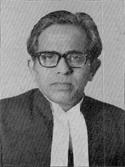The 16th Chief Justice of India, post-Independence was Yeshwant Vishnu Chandrachud who served as the CJI from year 1978 to 1985.
Former CJI has marked his name in the history of Supreme court, by being the longest-serving Chief Justice in for seven years and four months.
On July 12th 1920 born in the mofussil town of Pune, Yeshwant Chandrachud was a bright child from the very beginning.He completed his graduation in the field of
Economics and history from the famous Elphinstone College, Bombay. Law was his passion and he obtained his law degree from no other than the best ILS Law College,in year 1942.
In the year 1943, he was enrolled as an advocate in the High Court of Bombay .Yeshwant Chandrachud was a dynamic man who held a position of a part-time Professor of Law in Government Law College, Bombay, from 1949 to 1952.
In the year 1961, he was escalated to the position of Judge at the Bombay High Court, while in the year 1972, he was given the seat as one of the judicial head in Supreme Court of one of the biggest democracies of the World.
Year 1978 paved a new way for him, after he was appointed as the Chief Justice of India in 1978.
Justice Chandrachud took the oath of the office Chandrachud during the term of the Janta Government. When the Indira Gandhi government came to power, he became a strong opponent of the government.
An excerpt is found in one of the very known books on judicial law which states that although the entire judicial system was pressured to conform, the ruling party zeroed its attack on the pater familias.
It reads that unlike Justice Bhagwati, who was labelled as a Congress (I) man for his laudatory letter to Mrs. Gandhi, the New CJI Chandrachud was iron hand, he did not let any thing slip in between.
As the CJI Chandrachud was appointed Chief Justice of the Supreme Court of India by the Janata government, it called for a disqualification in itself under the new regime.
Chandrachud was not liked by the Gandhis for sending Sanjay to jail in 1978 and also for turning volte face during the Janata period.
It is said that in 1981, when things were really hot in politics, an MP named Ashoke Sen,from Congress (I) MP and the President of the Supreme Court Bar Association also hinted for a motion of impeachment by Parliament.
Fearless like his name Yashwant, defend the judiciary against executive interference and called for union of Bar and the bench. united as this was ‘the only way we could fight the provocation and attack on the judges'(As perBhagwan D. Dua, A Study in Executive-Judicial Conflict: The Indian )
CJI Chandrachud
gave some historic judgements including one of which was the Kissa Kursi Ka case, where Sanjay Gandhi was remanded to 30 days in judicial custody by the Supreme Court.
During his tenure, he authored a total of 338 judgments. He authored the most judgments in 1977 (48).
Privacy is a fundamental right, overruling the 1976 verdict and terming it as “seriously flawed.” Justice. Chandrachud gave the order with a nine-judge Constitution Bench .
The Major Judgements by justice Chandrachud include
In Minerva Mills Ltd. v Union of India (1980): In this the CJI with a five-judge Bench took a big decision on the constitutionality of the Constitution (42nd Amendment) Act, 1976. The CJI Chandrachud ordered that under Article 368 of the Constitution, Parliament cannot expand its amending power to acquire for itself the right to repeal or abrogate the Constitution or to destroy its basic and essential features.
Another Historical case in the list of Senior Chandrachud is that of Shah Bano Begum case(1985) where a bench of a five-judge Bench headed by Chandrachud adjudicated on rights of divorced Muslim women along with their maintenance.
The Bench then imposed section 125 of the Criminal Procedure Code to maintain indigent close relatives applied to all citizens irrespective of religion.
Shah Bano is a judgement as the case caused the Rajiv Gandhi government, to pass the Muslim Women (Protection of Rights on Divorce) Act, 1986 which diluted the judgment of the Supreme Court.
Another major matter was A.D.M. Jalbalpur v Shivakant Shukla (1976), famously known as the ‘Habeas Corpus case’, where a bench of five-judges decided that the Right to Life under the Indian Constitution could be suspended during an Emergency
In Gurbaksh Singh Sibbia v State of Punjab (1980)This matter was again put before a bench of five-judge who were adjudicating on laws of anticipatory bail.
The CJI Chandrachud held that laws on anticipatory bail must be read in light of Article 21 of the Indian Constitution and court can decide or impose restrictions on the grant of bail on a case-by-case basis.
Another very historical matter undertaken by the CJI was that of Olga Tellis v Bombay Municipal Corporation (1985) where The CJI said that The Bench ruled that the Right to Life includes the Right to Livelihood.The Bench headed by Chandrachud in the ,matter expanded the scope of the Right to Life under the Indian Constitution.


